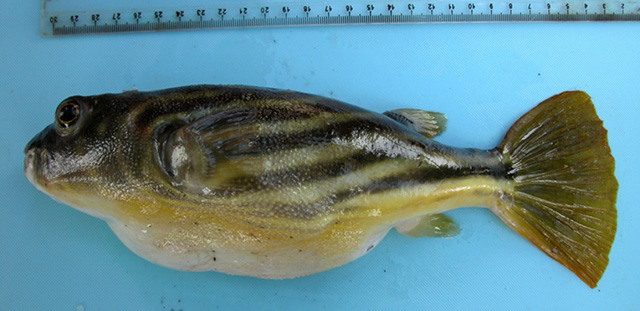| Tetraodontidae (Puffers), subfamily: Tetraodontinae |
| 43 cm TL (male/unsexed); max.weight: 1,000.0 g; max. reported age: 5 years |
|
demersal; freshwater; brackish; pH range: 7; dH range: 10, |
| Africa: Nile basin (Ref. 28714, 58460), Chad (Ref. 367, 57417), Senegal, Gambia, Geba, Volta River basins (Ref. 57417). Also found in Lake Turkana in Kenya (Ref. 52331). |
|
Dorsal spines (total): 2-3; Dorsal soft rays (total): 9-10; Anal spines: 2-2; Anal soft rays: 7-8. Diagnosis: skin scaleless, but head and body covered with small spines except on snout and caudal region; teeth form beak-like structure consisting in each jaw of two pieces fused on midline and covered by layer of enamel; nostrils consisting of two fleshy lobes placed in front of folded collar surrounding the opening; two pairs of non-perforated nasal tentacles; dorsal and anal fins short and placed far back on body; pectoral fins well developed; no pelvic fins; caudal fin rounded, its length comprised 3 times in SL; longitudinal stripes along sides of body in adults; black-rimmed red ocelli (eyespots) present in juveniles (Ref. 57417).
Description: body stocky; caudal fin about as long as head; gill rakers short and aligned in two rows, numbering 10-16 on first gill arch (Ref. 57417).
Colouration: adults bright yellow in life, with usually 7 longitudinal black stripes on sides of body and caudal peduncle; belly white and fins yellowish, caudal fin bright yellow to orange; young individuals have different colour pattern, with several rows of black-rimmed brick-red ocelli on the posterior region; these ocelli become elongate with growth, coalescing and forming longitudinal stripes of adults (Ref. 57417). |
| Found in large rivers (Ref. 2829), open water, weed beds and vegetated fringes; feeds on mollusks (Ref. 28714). Ventral pocket communicates gill chamber with oesophagus, allowing fish to inflate its body like a ball (Ref. 57417). |
|
Least Concern (LC); Date assessed: 01 November 2019 Ref. (130435)
|
| harmless |
Source and more info: www.fishbase.org. For personal, classroom, and other internal use only. Not for publication.

